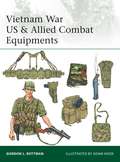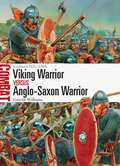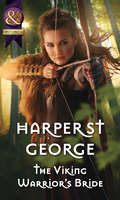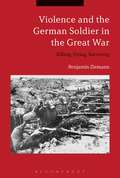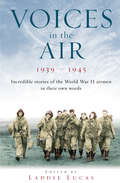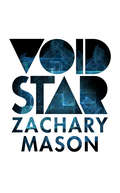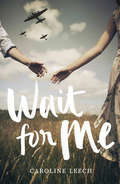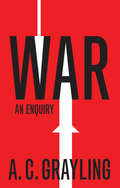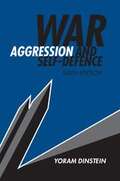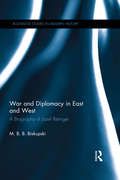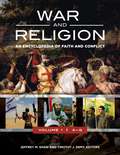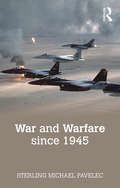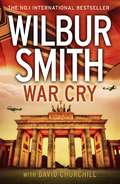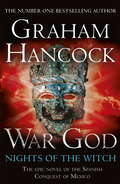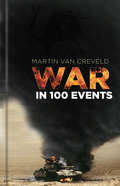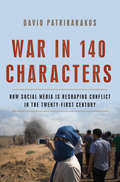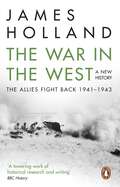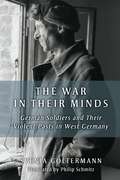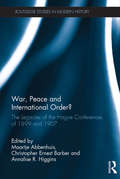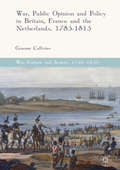- Table View
- List View
Vietnam War US & Allied Combat Equipments (Elite)
by Adam Hook Gordon L. RottmanOver the eight years of the Vietnam War, US forces used three major types of equipment sets, with numerous modifications for particular circumstances. Different equipments were also used by Special Forces, the South Vietnamese, and other allied ground troops.Vietnam War US & Allied Combat Equipments offers a comprehensive examination of the gear that US and allied soldiers had strapped around their bodies, what they contained, and what those items were used for. Fully illustrated with photographs and artwork detailing how each piece of equipment was used and written by a Special Forces veteran of the conflict, this book will fascinate enthusiasts of military equipment and will be an ideal reference guide for re-enactors, modellers and collectors of Vietnam War memorabilia.
Viking Warrior vs Anglo-Saxon Warrior: England 865–1066 (Combat #27)
by Peter Dennis Gareth WilliamsIn the two centuries before the Norman invasion of England, Anglo-Saxon and Viking forces clashed repeatedly in bloody battles across the country. Repeated Viking victories in the 9th century led to their settlement in the north of the country, but the tide of war ebbed and flowed until the final Anglo-Saxon victory before the Norman Conquest. Using stunning artwork, this book examines in detail three battles between the two deadly foes: Ashdown in 871 which involved the future Alfred the Great; Maldon in 991 where an Anglo-Saxon army sought to counter a renewed Viking threat; and Stamford Bridge in 1066, in which King Harold Godwinesson abandoned his preparations to repel the expected Norman invasion in order to fight off Harald Hard-Counsel of Norway.Drawing upon historical accounts from both English and Scandinavian sources and from archaeological evidence, Gareth Williams presents a detailed comparison of the weaponry, tactics, strategies and underlying military organization of the Anglo-Saxons and Vikings, and considers the developments which took place on both sides in the two centuries of Viking incursions into Anglo-Saxon England.
The Viking Warrior's Bride: Western Christmas Brides His Mistletoe Wager The Viking Warrior's Bride (Viking Warriors #4)
by Harper St. GeorgeA battle for power and passion
Violence and the German Soldier in the Great War: Killing, Dying, Surviving
by Benjamin ZiemannTranslated into English as the Winner of the Geisteswissenschaften International Translation Prize for Work in the Humanities and Social Sciences 2015.During the Great War, mass killing took place on an unprecedented scale. Violence and the German Soldier in the Great War explores the practice of violence in the German army and demonstrates how he killing of enemy troops, the deaths of German soldiers and their survival were entwined. As the war reached its climax in 1918, German soldiers refused to continue killing in their droves, and thus made an active contribution to the German defeat and ensuing revolution. Examining the postwar period, the chapters of this book also discuss the contested issue of a 'brutalization' of German society as a prerequisite of the Nazi mass movement. Biographical case studies on key figures such as Ernst Jünger demonstrate how the killing of enemy troops by German soldiers followed a complex set of rules. Benjamin Ziemann makes a wealth of extensive archival work available to an Anglophone audience for the first time, enhancing our understanding of the German army and its practices of violence during the First World War as well as the implications of this brutalization in post-war Germany. This book provides new insights into a crucial topic for students of twentieth-century German history and the First World War.
Violence and the German Soldier in the Great War: Killing, Dying, Surviving
by Benjamin ZiemannTranslated into English as the Winner of the Geisteswissenschaften International Translation Prize for Work in the Humanities and Social Sciences 2015.During the Great War, mass killing took place on an unprecedented scale. Violence and the German Soldier in the Great War explores the practice of violence in the German army and demonstrates how he killing of enemy troops, the deaths of German soldiers and their survival were entwined. As the war reached its climax in 1918, German soldiers refused to continue killing in their droves, and thus made an active contribution to the German defeat and ensuing revolution. Examining the postwar period, the chapters of this book also discuss the contested issue of a 'brutalization' of German society as a prerequisite of the Nazi mass movement. Biographical case studies on key figures such as Ernst Jünger demonstrate how the killing of enemy troops by German soldiers followed a complex set of rules. Benjamin Ziemann makes a wealth of extensive archival work available to an Anglophone audience for the first time, enhancing our understanding of the German army and its practices of violence during the First World War as well as the implications of this brutalization in post-war Germany. This book provides new insights into a crucial topic for students of twentieth-century German history and the First World War.
Voices In The Air 1939-1945: Incredible Stories Of The World War Ii Airmen In Their Own Words
by Laddie LucasA unique and enthralling anthology compiled by WWII flying ace, Laddie Lucas, Voices in the Air tells the story of the air battles of the Second World War in the voices of those who took part. Drawn largely on the writings of the combatants themselves from all sides of the conflict, this book offers a vivid and highly individual account of the great aerial campaigns of WWII. From a thrilling account of the first sustained dogfight between Spitfire and Messerschmitt in 1940, to an eighteen-year-old Japanese suicide pilot's last letter home and the Luftwaffe leaders' analysis of 'what went wrong' after the Battle of Britain, the book dramatically deals with every aspect of the war. Full of stories of astonishing escapades, incredible bravery, dogged persistence and moving feats of arms, Voices in the Air honours both the sung and the unsung heroes of the war.
Void Star: A Novel
by Zachary MasonNot far in the future the seas have risen and the central latitudes are emptying but it’s still a good time to be rich in San Francisco where weapons drones patrol the skies to keep out the multitudinous poor. Irina isn’t rich, not quite, but she does have an artificial memory that gives her perfect recall, and lets her act as a medium between her various employers and their AIs, which are complex to the point of opacity. It’s a good gig, paying enough for the annual visits to the Mayo Clinic that keep her from ageing.Kern has no such access; he's one of the many refugees in the sprawling drone-built favelas on the city’s periphery, where he lives like a monk, training relentlessly in martial arts, scraping by as a thief and an enforcer. Thales is from a different world entirely – the mathematically-inclined scion of a Brazilian political clan, he's fled to L.A. after the attack that left him crippled and his father dead. A ragged stranger accosts Thales and demands to know how much he can remember. Kern flees for his life after robbing the wrong mark. Irina finds a secret in the reflection of a laptop’s screen in her employer’s eyeglasses. None are safe as they’re pushed together by subtle forces that stay just out of sight.Vivid, tumultuous and propulsive, Void Star is Zachary Mason’s mind-bending follow-up to his bestselling debut The Lost Books of the Odyssey.
Wait for Me
by Caroline LeechCan their love survive a war? A breathtaking WW2 romance for fans of CODE NAME VERITY and BETWEEN SHADES OF GREY.
War: An Enquiry (Vices And Virtues Ser.)
by A. C. GraylingA renowned philosopher challenges long-held views on just wars, ethical conduct during war, why wars occur, how they alter people and societies, and more For residents of the twenty-first century, a vision of a future without warfare is almost inconceivable. Though wars are terrible and destructive, they also seem unavoidable. In this original and deeply considered book, A. C. Grayling examines, tests, and challenges the concept of war. He proposes that a deeper, more accurate understanding of war may enable us to reduce its frequency, mitigate its horrors, and lessen the burden of its consequences. Grayling explores the long, tragic history of war and how warfare has changed in response to technological advances. He probes much-debated theories concerning the causes of war and considers positive changes that may result from war. How might these results be achieved without violence? In a profoundly wise conclusion, the author envisions “just war theory” in new moral terms, taking into account the lessons of World War II and the Holocaust and laying down ethical principles for going to war and for conduct during war.
War, Aggression And Self-defence
by Yoram DinsteinWar, Aggression and Self-Defence is an indispensable guide to international legal issues of war and peace, the crime of aggression, self-defence and its trigger, armed attack, and the different modalities of self-defence, as well as enforcement measures taken under the aegis of a binding decision of the Security Council. This new and fully updated 6th edition focuses on the key issues at the forefront of the contemporary international legal debate, as well as analysing the new armed conflicts in Syria, Ukraine and Georgia, re-examining the Kampala amendments on the crime of aggression and considering the phenomenon of 'robust' mandates of a peacekeeping force. Suitable for graduate and advanced undergraduate students, this market-leading book offers a wide-ranging and highly readable introduction to the legal issues surrounding war and self-defence.
War and Diplomacy in East and West: A Biography of Józef Retinger (Routledge Studies in Modern History)
by M. B. BiskupskiThe New York Times said of Józef Hieronim Retinger that he was on intimate terms with most leading statesmen of the Western World, including presidents of the United States. He has been repeatedly acknowledged as one of the principle architects of the movement for European unity after the World War II, and one of the outstanding creative political influences of the post war period. He has also been credited with being the dark master behind the so-called "Bilderberg Group," described variously as an organization of idealistic internationalists, and a malevolent global conspiracy. Before that, Retinger involved himself in intelligence activities during World War II and, given the covert and semi-covert nature of many of his activities, it is little wonder that no biography has appeared about him. This book draws on a broad range of international archives to rectify that.
War and Diplomacy in East and West: A Biography of Józef Retinger (Routledge Studies in Modern History)
by M. B. BiskupskiThe New York Times said of Józef Hieronim Retinger that he was on intimate terms with most leading statesmen of the Western World, including presidents of the United States. He has been repeatedly acknowledged as one of the principle architects of the movement for European unity after the World War II, and one of the outstanding creative political influences of the post war period. He has also been credited with being the dark master behind the so-called "Bilderberg Group," described variously as an organization of idealistic internationalists, and a malevolent global conspiracy. Before that, Retinger involved himself in intelligence activities during World War II and, given the covert and semi-covert nature of many of his activities, it is little wonder that no biography has appeared about him. This book draws on a broad range of international archives to rectify that.
War and Religion [3 volumes]: An Encyclopedia of Faith and Conflict [3 volumes]
by Jeffrey M. Shaw and Timothy J. Demy EditorsThis three-volume reference provides a complete guide for readers investigating the crucial interplay between war and religion from ancient times until today, enabling a deeper understanding of the role of religious wars across cultures.Containing some 500 entries covering the interaction between war and religion from ancient times, the three-volume War and Religion: An Encyclopedia of Faith and Conflict provides students with an invaluable reference source for examining two of the most important phenomena impacting society today. This all-inclusive reference work will serve readers researching specific religious traditions, historical eras, wars, battles, or influential individuals across all time periods.The A–Z entries document ancient events and movements such as the First Crusade that began at the end of the 10th century as well as modern-day developments like ISIS and Al Qaeda. Subtopics throughout the encyclopedia include religious and military leaders or other key people, ideas, and weapons, and comprehensive examinations of each of the major religious traditions' views on war and violence are presented. The work also includes dozens of primary source documents—each introduced by a headnote—that enable readers to go directly to the source of information and better grasp its historical significance. The in-depth content of this set benefits high school and college students as well as scholars and general readers.
War and Warfare since 1945 (The Making of the Contemporary World)
by Sterling M. PavelecBeginning with an exploration into the question of what war is, War and Warfare since 1945 provides a chronological analysis of military history since the end of World War II extending through to an analysis of the limits of modern warfare in the nuclear age with the purpose of examining why war occurs and how it is carried out. Among the types of conflict considered within the book are: state conflicts civil wars proxy wars terrorism and counterterrorism insurgency genocide. Both theoretical and historical, War and Warfare since 1945 also explores the definitions, ethics, morals, and effects of the use of militaries in and after war, and puts forward important questions about how wars are resolved. The wars discussed include the first Arab-Israeli War, the Chinese Civil War, the Korean War, the Cold War, the Vietnam War, and the Iraq war. The book concludes with an investigation into modern war and speculation on the changing face of warfare.
War and Warfare since 1945 (The Making of the Contemporary World)
by Sterling M. PavelecBeginning with an exploration into the question of what war is, War and Warfare since 1945 provides a chronological analysis of military history since the end of World War II extending through to an analysis of the limits of modern warfare in the nuclear age with the purpose of examining why war occurs and how it is carried out. Among the types of conflict considered within the book are: state conflicts civil wars proxy wars terrorism and counterterrorism insurgency genocide. Both theoretical and historical, War and Warfare since 1945 also explores the definitions, ethics, morals, and effects of the use of militaries in and after war, and puts forward important questions about how wars are resolved. The wars discussed include the first Arab-Israeli War, the Chinese Civil War, the Korean War, the Cold War, the Vietnam War, and the Iraq war. The book concludes with an investigation into modern war and speculation on the changing face of warfare.
War Cry: A Courtney Family Novel
by Wilbur Smith‘That time is upon us. I can feel it coming. That evil barbarian will not be satisfied until he has engulfed the whole world in war and death. I fear for us all.’ In a triumphant return to his much-loved Courtney series, Wilbur Smith introduces us to the bravest new member of the famed family, Saffron Courtney.
War God: War God Trilogy Book One (War God #1)
by Graham HancockA young girl called Tozi stands at the bottom of a pyramid, waiting to be led to the top where her heart will be cut out...Pepillo, a Spanish orphan who serves a sadistic Dominican friar, is aboard the Spanish fleet as it sails towards Mexico...This is the epic story of the clash of two empires, two armies and two gods of war. Five hundred desperate adventurers are about to pit themselves against the most brutal armies of the ancient Americas, armies hundreds of thousands strong. This is a war of gods and men. Dark powers that work behind the scenes of history show their hand as the prophecy of the return of Quetzalcoatl is fulfilled with the arrival of Cortes. The Aztec ruler Moctezuma fights to maintain the demands of the war god Huitzilopochtli for human sacrifice. The Spanish Inquisition is planning an even greater blood-letting. Caught up in the headlong collision between two gods of war are Tozi, Pepillo and the beautiful sex slave Malinal whose hatred of Moctezuma runs so deep she will sell out her own land and people to destroy him.
War in 100 Events
by Martin van Creveld‘War is a duel written large.’ How did we get from clubs and spears to machine guns and drone missiles? What led to the human race firing projectiles across a no-man’s-land, from straightforward warfare to spies and insurgency? Here renowned military historian Martin van Creveld has compiled a concise guide to the history of war in 100 key events, from 10,000 BCE to the present day: Stone Age ‘wars’; Vikings raids; medieval conflicts; revolutionary wars; Napoleonic wars; world wars; the Iraq war; women in war and much more. With intriguing facts and a worldwide range, War in 100 Events is an immensely entertaining volume for military buffs and laymen alike.
War in 140 Characters: How Social Media Is Reshaping Conflict in the Twenty-First Century
by David PatrikarakosA leading foreign correspondent looks at how social media has transformed the modern battlefield, and how wars are fought Modern warfare is a war of narratives, where bullets are fired both physically and virtually. Whether you are a president or a terrorist, if you don't understand how to deploy the power of social media effectively you may win the odd battle but you will lose a twenty-first century war. Here, journalist David Patrikarakos draws on unprecedented access to key players to provide a new narrative for modern warfare. He travels thousands of miles across continents to meet a de-radicalized female member of ISIS recruited via Skype, a liberal Russian in Siberia who takes a job manufacturing "Ukrainian" news, and many others to explore the way social media has transformed the way we fight, win, and consume wars-and what this means for the world going forward.
The War in the West: Volume 2: The Allies Fight Back 1941-43
by James Holland'Ranks as a towering work of historical research and writing' – Nigel Jones, BBC History MagazineIn the second volume of his acclaimed new history of the Second World War, James Holland examines the momentous turning points of 1941–1943: Hitler’s invasion of Russia; America’s entry into the conflict; the devastating Thousand Bomber Raids over Germany; the long struggle in the deserts of North Africa; and the defeat of the U-boats in the crucial Battle of the Atlantic. As in his first volume, Germany Ascendant, he interweaves his account of the well-known events of the period with the personal stories of individuals caught up in them - on all sides. Through interviews, letters, diaries and reports, he allows us to see the war not just from the perspective of politicians, military commanders and strategists, but also through the eyes of civilians bombed out of their homes, resistance members stranded in the frozen Norwegian winter, sailors risking their lives in the Atlantic convoys, German aces striving for supremacy in the air, and ordinary soldiers battling for survival in the scorching sands of Libya. He also looks behind the scenes at the all-important ‘machinery’ of war: the manufacturing, farming and vital supply lines that underpinned the entire conflict and ultimately determined its course. From the battle fronts on land, sea and air, to the streets, fields and factories of Britain, America and Germany, he paints a dramatic and compelling portrait of these pivotal years when the tide began to turn. Combining his own research with only recently accessible archive material, Holland looks afresh at this cataclysmic conflict, reassessing long-held views and challenging conventional assumptions. The result is ground-breaking history that redefines the war in the West and makes us think again about the events that shaped our modern world.
The War in Their Minds: German Soldiers and Their Violent Pasts in West Germany
by Svenja Goltermann Philip SchmitzHistorians are increasingly looking at the sacrifices Germans had to make during World War II. In this context, Svenja Goltermann has taken up a particularly delicate topic, German soldiers’ experience of violence during the war, and repercussions of this experience after their return home. Part I of her book explores the ways in which veterans’ experiences of wartime violence reshaped everyday family life, involving family members in complex ways. Part II offers an extensive analysis of the psychiatric response to this new category of patient, and in particular the reluctance of psychiatrists to recognize the psychic afflictions of former POWs as constituting the grounds for long-term disability. Part III analyzes the cultural representations of veterans’ psychic suffering, encompassing the daily press, popular films, novels, and theater. Originally published in German as Die Gesellschaft der Uberlebenden, The War in Their Minds examines hitherto unused source material—psychiatric medical files of soldiers—to make clear how difficult it was for the soldiers and their families to readjust to normal, everyday life. Goltermann allows these testimonies of violence, guilt, justification, and helplessness speak for themselves and sensitively explores how the pension claims of returning soldiers were to compete with the claims of the Holocaust victims to compensation.
War, Peace and International Order?: The Legacies of the Hague Conferences of 1899 and 1907 (Routledge Studies in Modern History)
by Maartje Abbenhuis Christopher Ernest Barber Annalise R. HigginsThe exact legacies of the two Hague Peace Conferences remain unclear. On the one hand, diplomatic and military historians, who cast their gaze to 1914, traditionally dismiss the events of 1899 and 1907 as insignificant footnotes on the path to the First World War. On the other, experts in international law posit that The Hague’s foremost legacy lies in the manner in which the conferences progressed the law of war and the concept and application of international justice. This volume brings together some of the latest scholarship on the legacies of the Hague Peace Conferences in a comprehensive volume, drawing together an international team of contributors.
War, Peace and International Order?: The Legacies of the Hague Conferences of 1899 and 1907 (Routledge Studies in Modern History)
by Maartje Abbenhuis Christopher Ernest Barber Annalise R. HigginsThe exact legacies of the two Hague Peace Conferences remain unclear. On the one hand, diplomatic and military historians, who cast their gaze to 1914, traditionally dismiss the events of 1899 and 1907 as insignificant footnotes on the path to the First World War. On the other, experts in international law posit that The Hague’s foremost legacy lies in the manner in which the conferences progressed the law of war and the concept and application of international justice. This volume brings together some of the latest scholarship on the legacies of the Hague Peace Conferences in a comprehensive volume, drawing together an international team of contributors.
War, Public Opinion and Policy in Britain, France and the Netherlands, 1785-1815
by Graeme CallisterThis book offers a detailed investigation of the influence of public opinion and national identity on the foreign policies of France, Britain and the Netherlands in the late eighteenth and early nineteenth centuries. The quarter-century of upheaval and warfare in Europe between the outbreak of the French Revolution and fall of Napoleon saw important developments in understandings of nation, public, and popular sovereignty, which spilled over into how people viewed their governments—and how governments viewed their people. By investigating the ideas and impulses behind Dutch, French and British foreign policy in a comparative context across a range of royal, revolutionary and republican regimes, this book offers new insights into the importance of public opinion and national identities to international relations at the end of the long eighteenth century.
War, Public Opinion and Policy in Britain, France and the Netherlands, 1785-1815
by Graeme CallisterThis book offers a detailed investigation of the influence of public opinion and national identity on the foreign policies of France, Britain and the Netherlands in the late eighteenth and early nineteenth centuries. The quarter-century of upheaval and warfare in Europe between the outbreak of the French Revolution and fall of Napoleon saw important developments in understandings of nation, public, and popular sovereignty, which spilled over into how people viewed their governments—and how governments viewed their people. By investigating the ideas and impulses behind Dutch, French and British foreign policy in a comparative context across a range of royal, revolutionary and republican regimes, this book offers new insights into the importance of public opinion and national identities to international relations at the end of the long eighteenth century.
